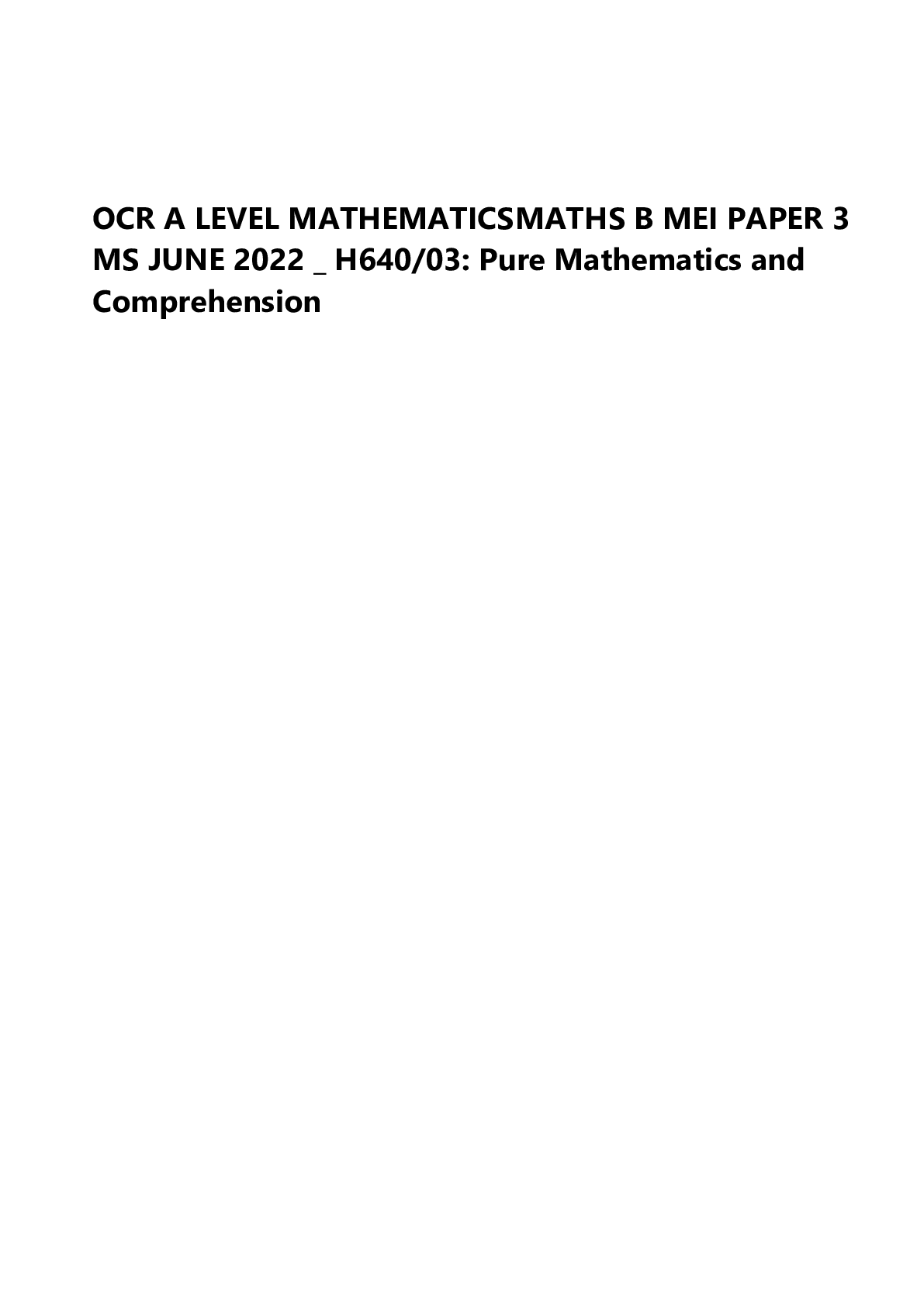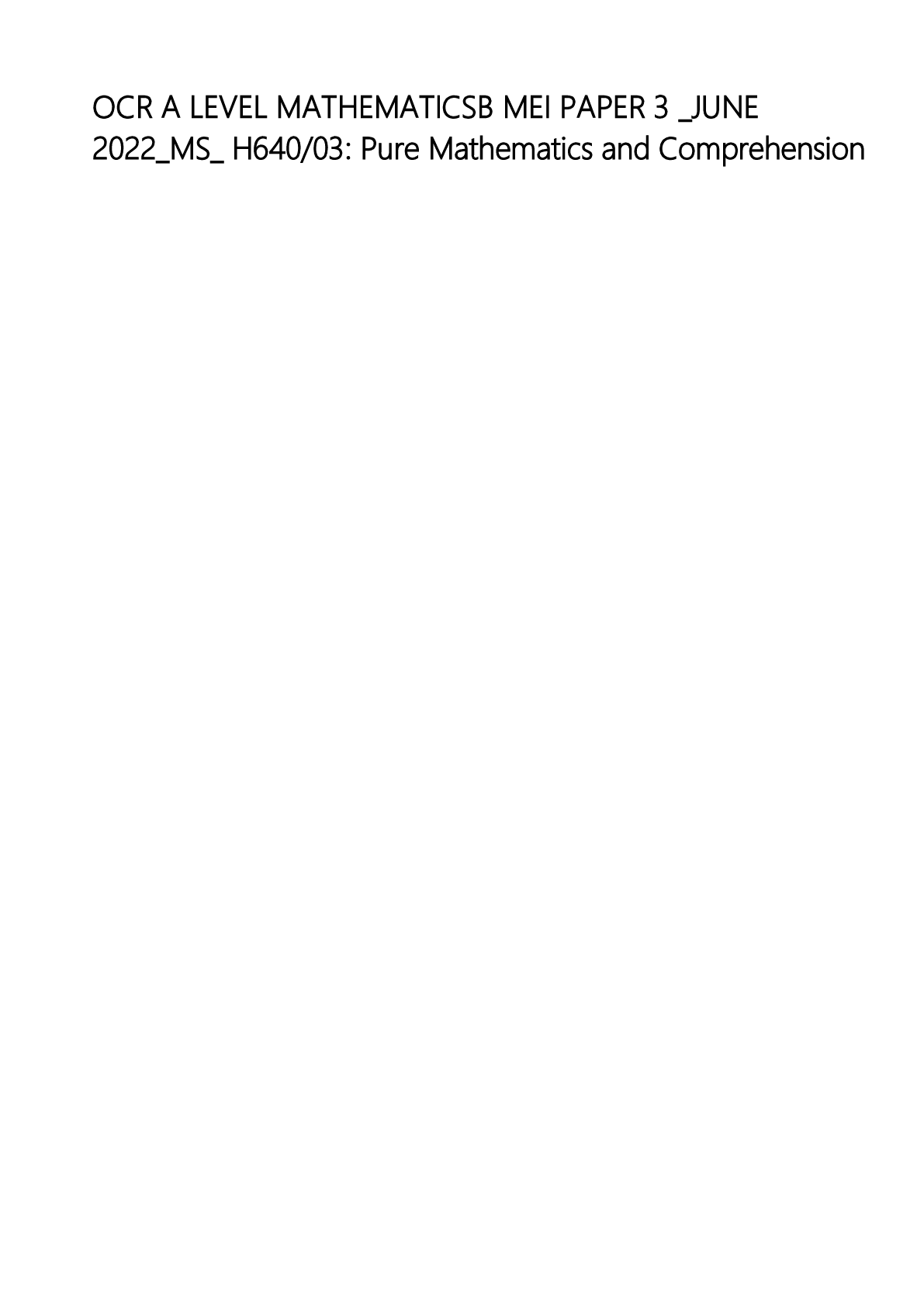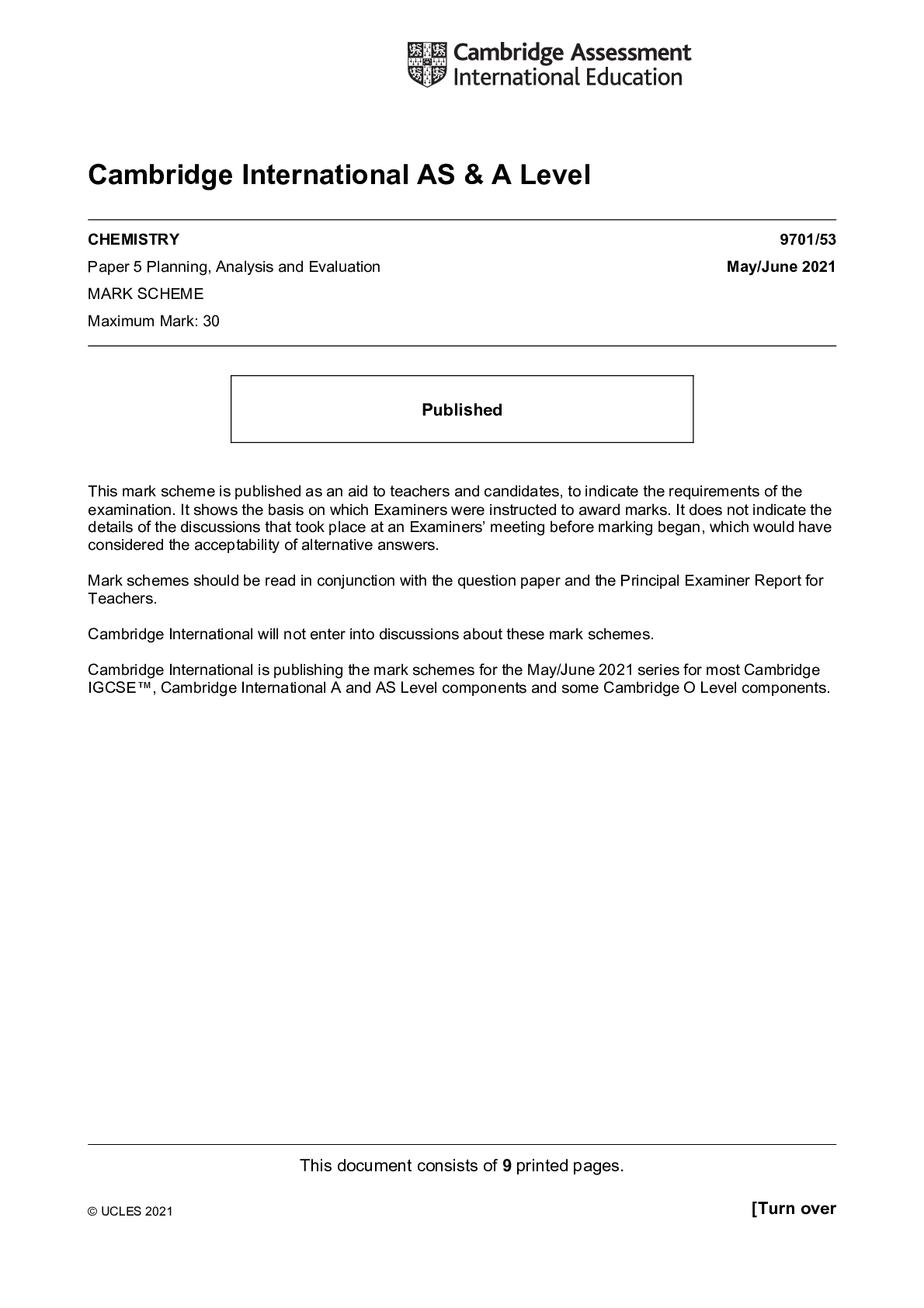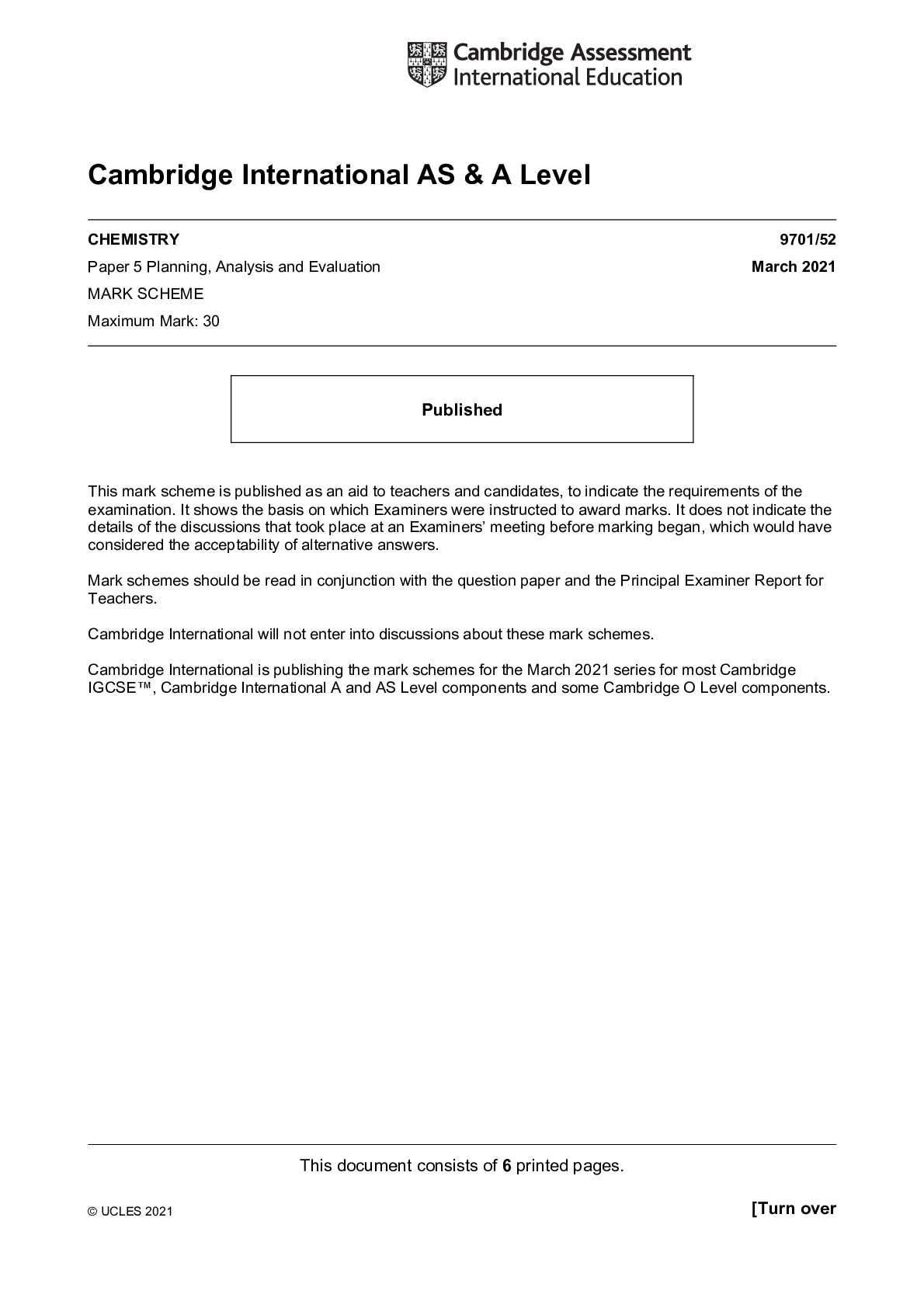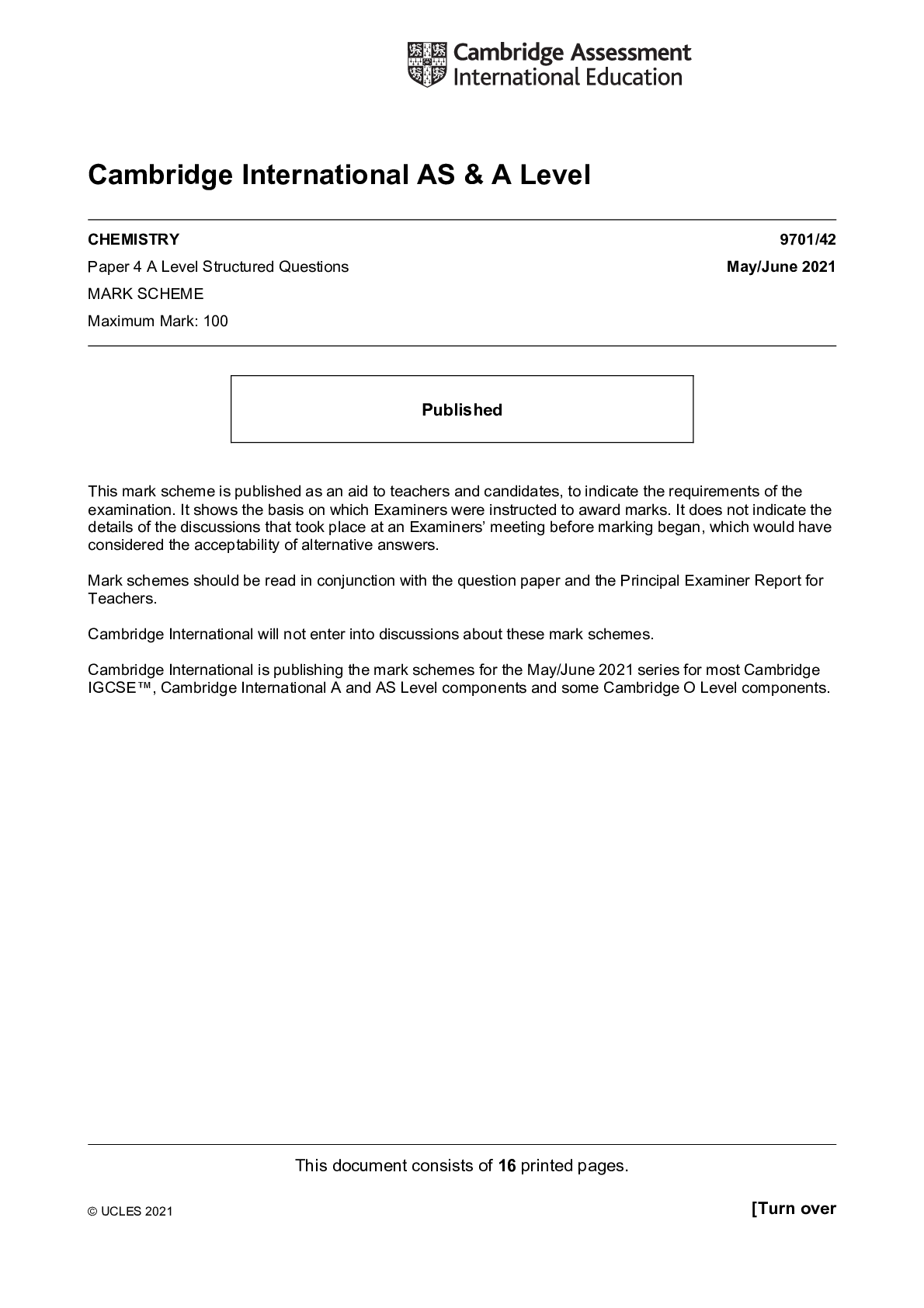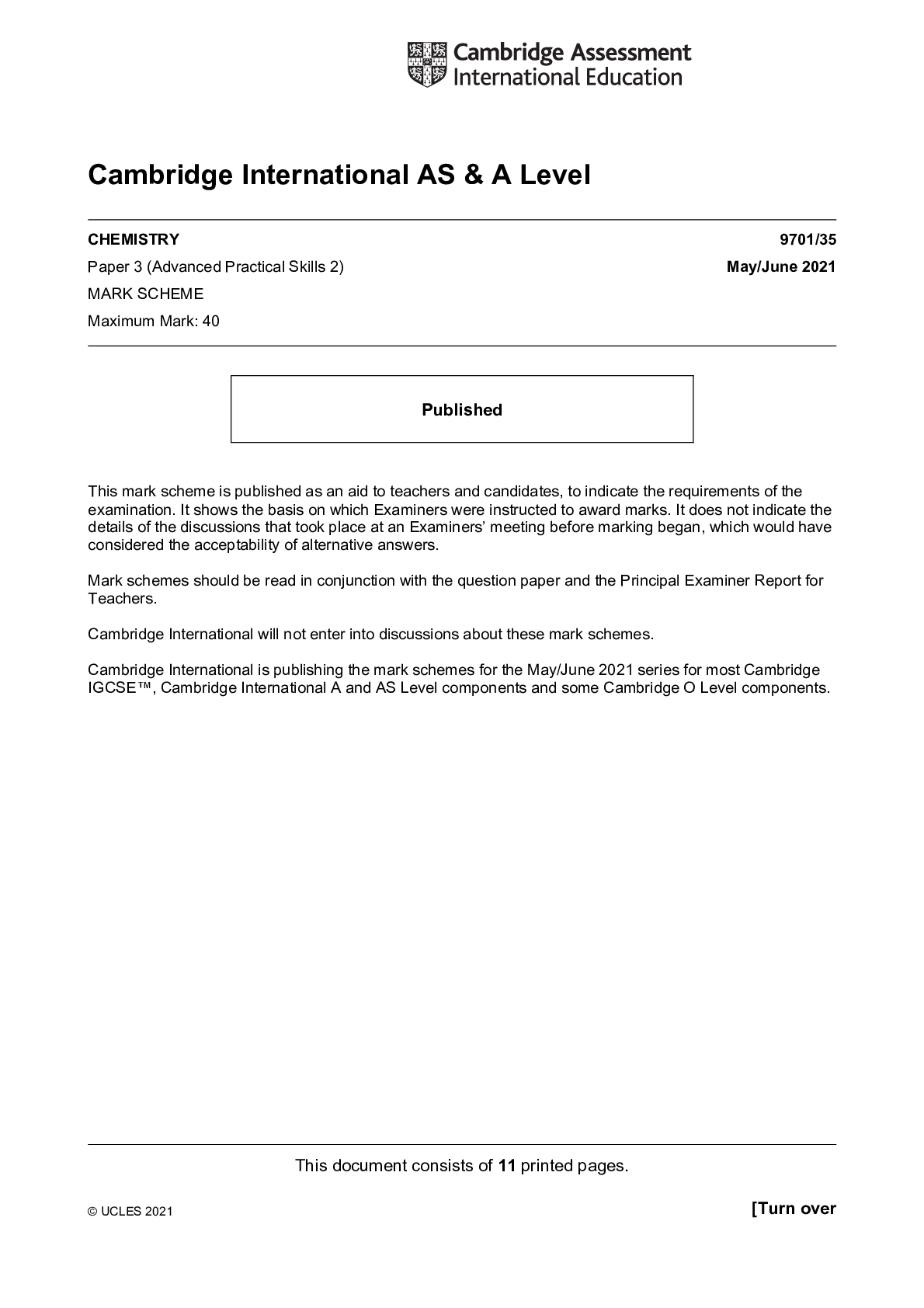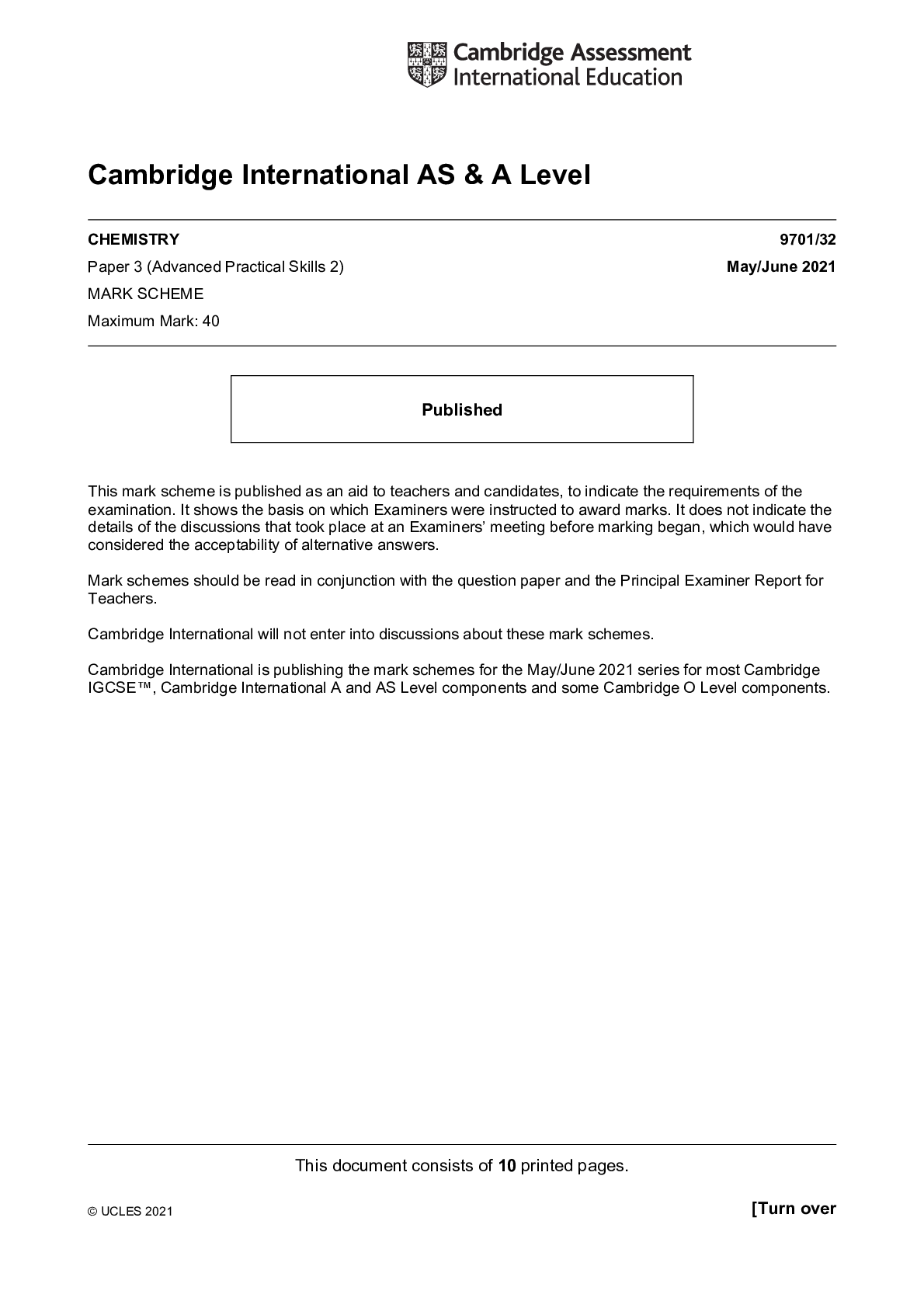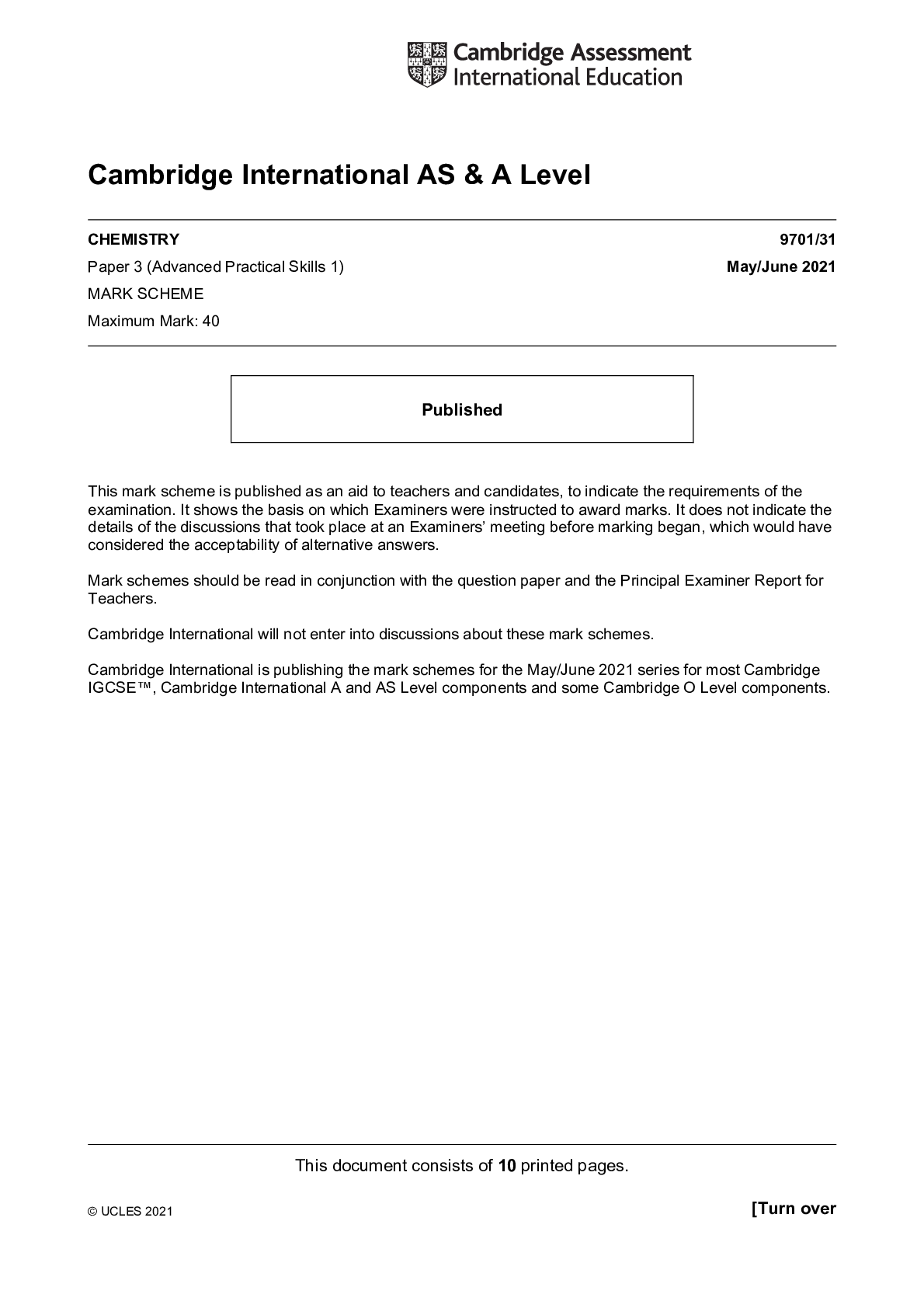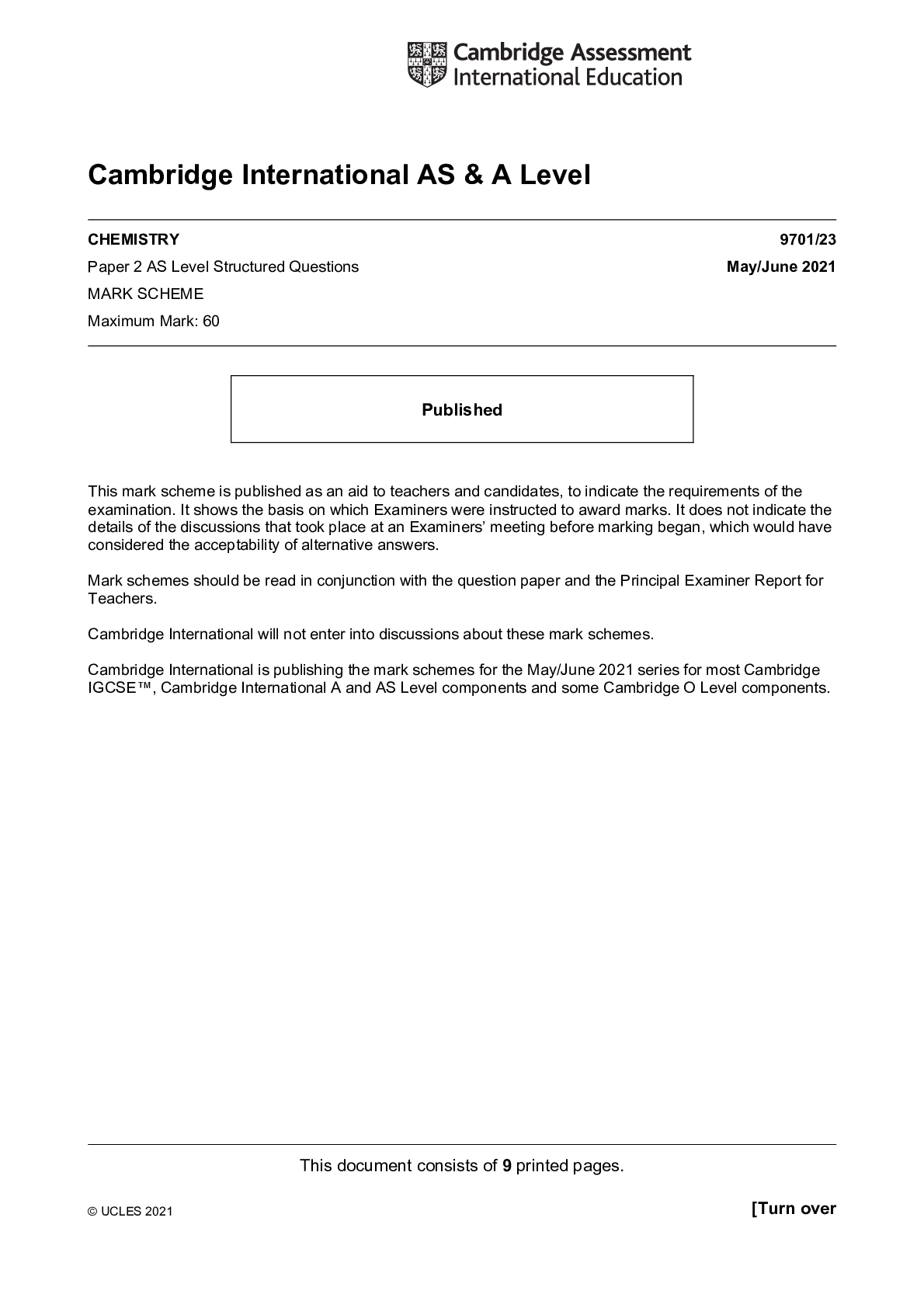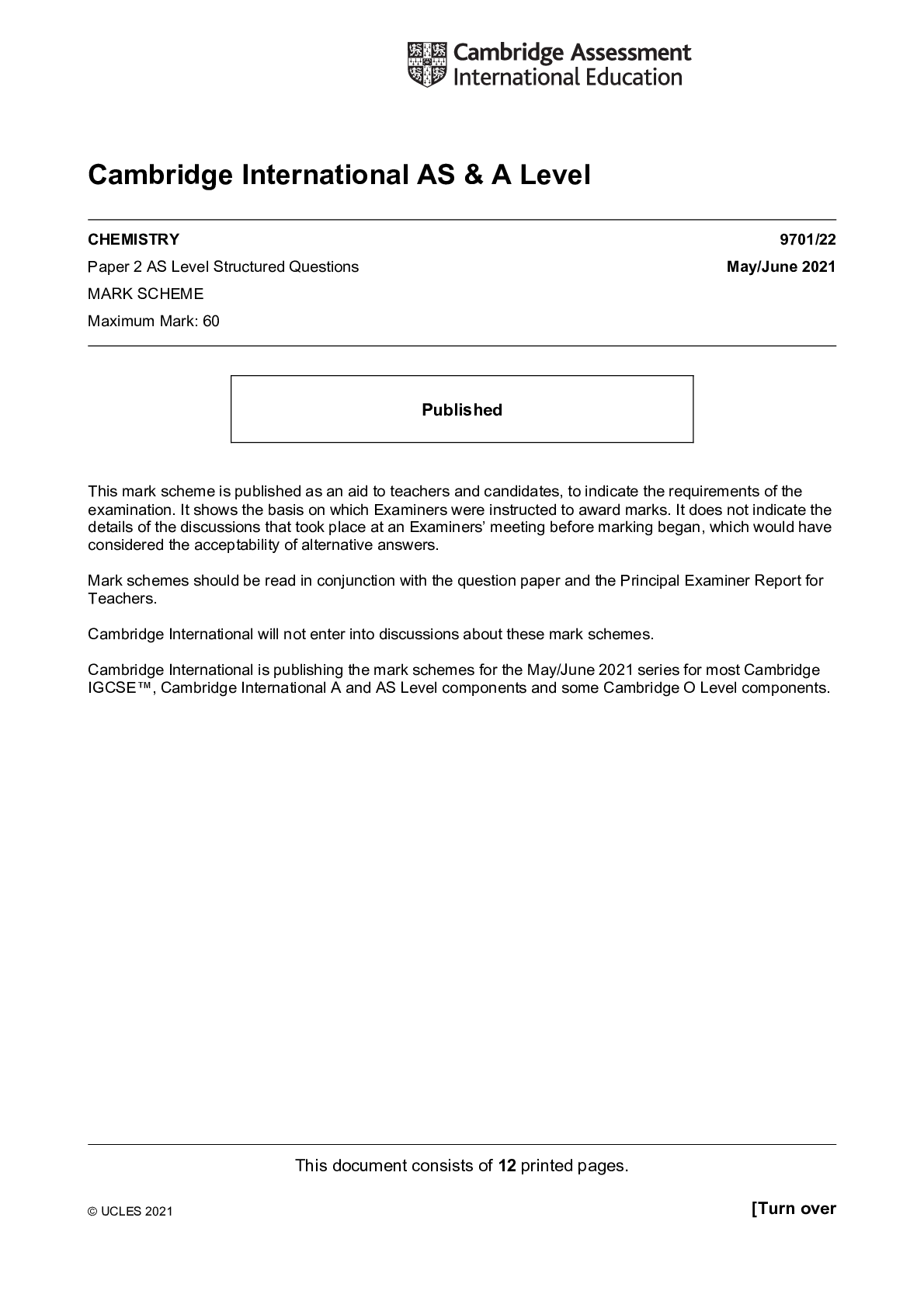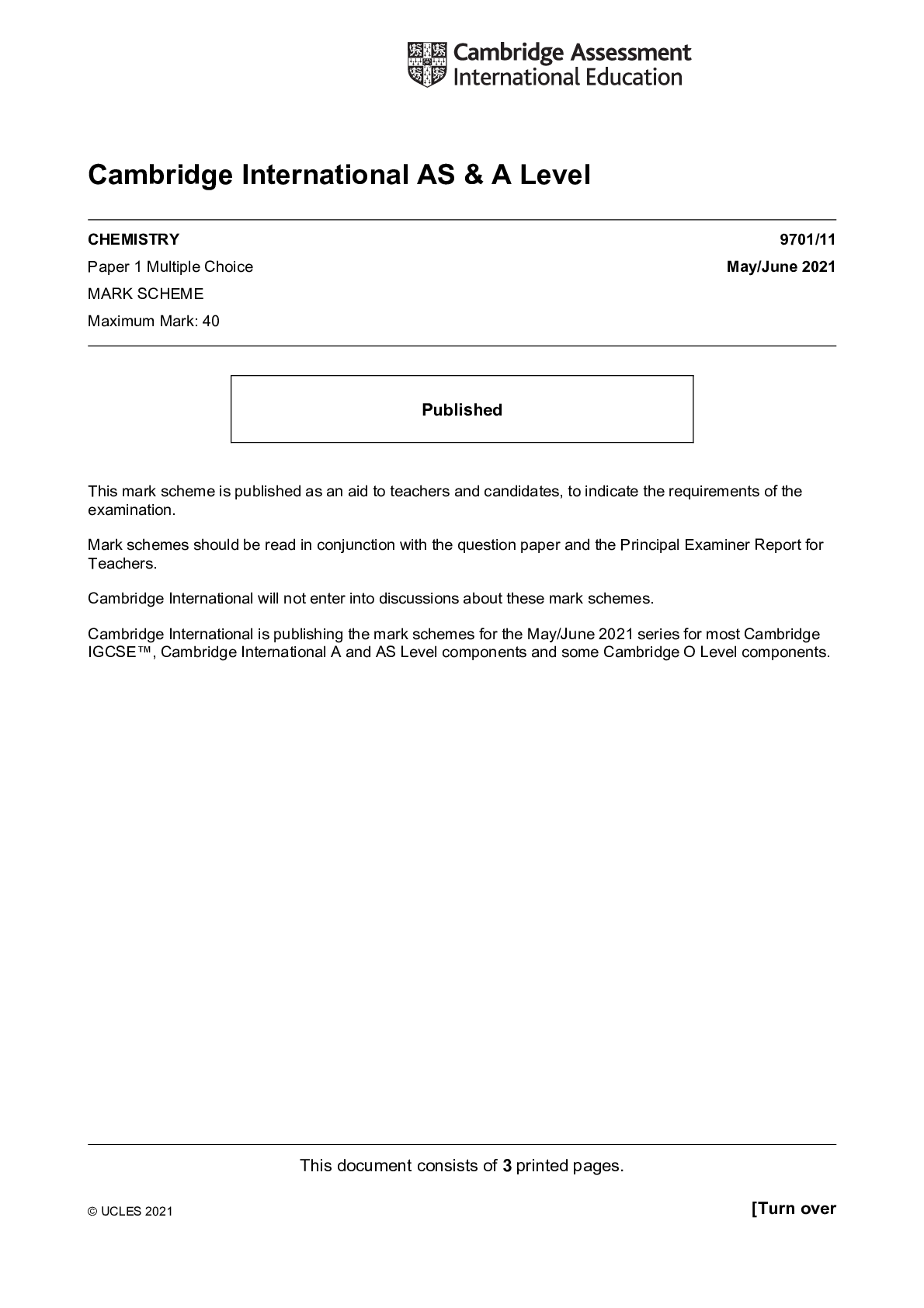Economics > MARK SCHEME > Mark Scheme (Results) Summer 2019 Pearson Edexcel GCE A Level in Economics A (9EC0) Paper 03 Microe (All)
Mark Scheme (Results) Summer 2019 Pearson Edexcel GCE A Level in Economics A (9EC0) Paper 03 Microeconomics and Macroeconomics
Document Content and Description Below
Mark Scheme (Results) Summer 2019 Pearson Edexcel GCE A Level in Economics A (9EC0) Paper 03 Microeconomics and MacroeconomicsEdexcel and BTEC Qualifications Edexcel and BTEC qualifications are ... awarded by Pearson, the UK’s largest awarding body. We provide a wide range of qualifications including academic, vocational, occupational and specific programmes for employers. For further information visit our qualifications websites at www.edexcel.com or www.btec.co.uk. Alternatively, you can get in touch with us using the details on our contact us page at www.edexcel.com/contactus. Pearson: helping people progress, everywhere Pearson aspires to be the world’s leading learning company. Our aim is to help everyone progress in their lives through education. We believe in every kind of learning, for all kinds of people, wherever they are in the world. We’ve been involved in education for over 150 years, and by working across 70 countries, in 100 languages, we have built an international reputation for our commitment to high standards and raising achievement through innovation in education. Find out more about how we can help you and your students at: www.pearson.com/uk Summer 2019 Publications Code 9EC0_03_1906_MS All the material in this publication is copyright © Pearson Education Ltd 2019General marking guidance • All candidates must receive the same treatment. Examiners must mark the last candidate in exactly the same way as they mark the first. • Mark schemes should be applied positively. Candidates must be rewarded for what they have shown they can do rather than be penalised for omissions. • Examiners should mark according to the mark scheme – not according to their perception of where the grade boundaries may lie. • All the marks on the mark scheme are designed to be awarded. Examiners should always award full marks if deserved, i.e. if the answer matches the mark scheme. Examiners should also be prepared to award zero marks if the candidate’s response is not worthy of credit according to the mark scheme. • Where some judgement is required, mark schemes will provide the principles by which marks will be awarded and exemplification/indicative content will not be exhaustive. • When examiners are in doubt regarding the application of the mark scheme to a candidate’s response, a senior examiner must be consulted before a mark is given. • Crossed-out work should be marked unless the candidate has replaced it with an alternative response.Question Number Answer Mark 1(a) Knowledge 2, Application 2, Analysis 1 NB an answer which sees highly concentrated as having a large number of firms will not earn knowledge or analysis marks Knowledge and analysis: 3 marks for e.g. • Identification of high concentration - high market share of some firms (1) few large firms dominate (1) uncompetitive (1) • Identification of market structure - there is a legal monopoly (Walkers) OR oligopoly OR duopoly (1) • Firms can set prices (1) control output (1) / monopoly power (1) • Interdependent (1) • High barriers to entry/exit (1) low contestability (1) Application: 2 marks for data references e.g. • Walkers have over 50% of market share (1) • Use of concentration ratio e.g. 2 firm CR 78.0% (2), 3 firm CR 82.2% (2) • Extract A refers to ban making market more competitive (1) implying prices are currently uncompetitive/high (1) • Extract A – high levels of advertising (1) • common features: they tend to be dominated by a small number of firms that sell multiple brands and that heavily advertise their products (1) NB Concentration ratio calculation can be awarded as analysis or application Award a maximum of 1 application mark if there is no reference to Figure 1 or Extract A (5)Question Number Answer Mark 1(b) Knowledge 2, Application 2, Analysis 2, Evaluation 2 Knowledge/ implicit understanding: (1+1) marks for reason e.g. • Educational/skills/wage differences • Changing patterns of trade/globalisation • Government policy/austerity/universal credit • Income generated from inheritance • Payments generated from debt • Race, gender, age, geographical issues • Changes in direct tax • Stage of the economic cycle/Financial Crisis 2008 • House prices (must relate to income not wealth) • Weakened power of trade unions • Level of unemployment/underemployment • Irrational behaviour/information gaps/myopia Application (1+1 or 2): • Any valid application to causing inequality in the UK or other developed country, e.g. unaffordable house prices in the UK mean the younger generation has little income after rent (1); cut in the top rate of income tax, rise in NICs, change in tax thresholds; university fees at £9250 a year is widening the income gap if fewer low income households go to university (1); pensions rising below average incomes (1); educational differences such as an economics degree has a higher impact on future earnings than other degrees (1) Analysis (1+1): • Linked development of the two points made Evaluation (1+1 or 2). Points might include discussion of: • The role of transfer payments/minimum wages in narrowing/failing to narrow inequality • Changes rather than levels of income inequality, absolute vs relative issues • Relationship with wealth e.g. as a more significant inequality issue • Relative significance of different factors e.g. direct taxes more proportional than indirect taxes (regressive) • Time lags e.g. education has effects as yet unfolded, government policy might change, Brexit has not yet happened. NB Do not allow indirect taxes or subsidies as KAA NB Use of Gini coefficient or Lorenz curves could be used as application or analysis (8)Question Number Indicative content Mark 1(c) Knowledge 2, Application 2, Analysis 4 • Firms are interdependent so they will respond in the face of what other firms might do • Firms may not reach the same outcome as if they operated alone • Firms are cutting prices because they want to expand market share/steal other firms’ markets • All firms responding in this way means that firms make less profit overall • Effects of advertising ban may make market more contestable, with possible effects on entrant • Price cuts could be a form of limit pricing, i.e. reducing contestability (effects on possible entrants may be shown) • Game theory e.g. a payoff matrix or kinked demand curve to illustrate behaviour, for example cartel-like or collusive behaviour, price leadership NB to access Level 3 there must be correct use of game theory and application to the data. (8) Level Mark Descriptor 0 A completely inaccurate response. Level 1 1–2 Displays isolated or imprecise knowledge and understanding of terms, concepts, theories and models. Use of generic or irrelevant information or examples. Descriptive approach which has no chains of reasoning or links between causes and consequences. Level 2 3–5 Displays elements of knowledge and understanding of economic principles, concepts and theories. Applies economic ideas and relates them to economic problems in context, although does not focus on the broad elements of the question. A narrow response; chains of reasoning are developed but the answer may lack balance. Level 3 6–8 Demonstrates accurate knowledge and understanding of the concepts, principles and models. Ability to link knowledge and understanding in context using relevant and focused examples which are fully integrated. Economic ideas are carefully selected and applied appropriately to economic issues and problems. The answer demonstrates logical and coherent chains of reasoning.Question Number Indicative content Mark 1(c) continued Evaluation 4 • Firms such as Walkers have significant market share and brand loyalty, even if competition lower price they may not switch • Use of context to show that firms are cutting prices because of a regulation and not because of the actions of other firms. No sign of interdependence. • Size of market shrinking overall so behaviour more aggressive • Firms setting low prices in a long run equilibrium might not the best option for the firms or other stakeholders. • Advertising ban affects children mainly - so price competition less needed for older target audiences that can still be targeted. • Reference to only 10% loss in sales compared to 15% - still a large impact on firms (Extract A). (4) Level Mark Descriptor 0 No evaluative comments. Level 1 1–2 Identification of generic evaluative comments without supporting evidence/reference to context. No evidence of a logical chain of reasoning. Level 2 3–4 Evaluative comments supported by relevant reasoning and appropriate reference to context. Evaluation recognises different viewpoints and/or is critical of the evidence.Question Number Indicative content Mark 1(d) Knowledge 4, Application 4, Analysis 8, Evaluation 9 16 marks for KAA, for effects of increased spending on education to promote heathy eating in the UK. Microeconomic effects may include: • Effects of increased demand for healthy foods/consumer surplus/increased prices (may include supply and demand diagram) or fall in price of HFSS foods • Positive externalities in consumption are internalised (may include divergent MSB and MPB diagram and corresponding movement toward social optimum at MSB=MSC) • Impact on firms which make unhealthy products – increased costs if they diversify/reduced demand e.g. use of healthier ingredients with higher costs. This might be shown on a cost/revenue diagram. • Increased profits for healthy food producers e.g. shown on a costs/revenue diagram • labour market issues, e.g. workforce becomes healthier, and reduced obesity might make workers more productive (increase marginal product) • Opportunity cost of spending on education Macroeconomic effects may include: • Effects on price level and output as G increases, with multiplier effects. May be shown by shift out in AD with effects on price level and real output. • Healthier workforce shifts out the LRAS, with impact of lower prices and higher output • Fiscal implications – crowding out, effect on balancing budget NB for a Level 4 response there must be micro and macro effect (s). Opportunity cost/shift in PPF/labour markets/competitiveness etc. can be used as micro or macro. 9 marks for evaluation – questioning might include: • Expansionary fiscal policies not necessarily happening. It might mean expenditure elsewhere is cut (opportunity cost arguments) • Trade-off between objectives e.g. increased spending might cause inflation, depends on the state of the fiscal balance, multiplier etc. • Questioning whether education is effective, or whether other policies are needed, e.g. tax, banning advertisements • Education might be counter-productive/role of state might be questioned e.g. government failure, crowding out effect (25)Knowledge, application and analysis Level Mark Descriptor 0 A completely inaccurate response. Level 1 1–4 Displays isolated or imprecise knowledge and understanding of terms, concepts, theories and models. Use of generic or irrelevant information or examples. Descriptive approach which has no chains of reasoning or links between causes and consequences. Level 2 5–8 Displays elements of knowledge and understanding of economic principles, concepts and theories. Applies economic ideas and relates them to economic problems in context, although does not focus on the broad elements of the question. A narrow response or superficial, two stage chains of reasoning only. Level 3 9–12 Demonstrates accurate knowledge and understanding of the concepts, principles and models. Ability to apply economic concepts and relate them directly to the broad elements of the question with evidence integrated into the answer. Analysis is clear and coherent, although it may lack balance. Chains of reasoning are developed but the answer may lack balance. Level 4 13–16 Demonstrates precise knowledge and understanding of the concepts, principles and models. Ability to link knowledge and understanding in context using appropriate examples. Analysis is relevant and focused with evidence fully and reliably integrated. Economic ideas are carefully selected and applied appropriately to economic issues and problems covering both microeconomic and macroeconomic factors. The answer demonstrates logical and coherent chains of reasoning. Evaluation Level Mark Descriptor 0 No evaluative comments. Level 1 1–3 Identification of generic evaluative comments without supporting evidence/reference to context. No evidence of a logical chain of reasoning. Level 2 4–6 Evidence of evaluation of alternative approaches which is unbalanced leading to unsubstantiated judgements. Evaluative comments with supporting evidence/reference to context and a partially-developed chain of reasoning.Level 3 7–9 Evaluative comments supported by relevant reasoning and appropriate reference to context. Evaluation recognises different viewpoints and is critical of the evidence provided and/or the assumptions underlying the analysis enabling informed judgements to be made.Question Number Indicative content Mark 1(e) Knowledge 4, Application 4, Analysis 8 Evaluation 9 16 marks for KAA, for effects of increase in tax on HFSS foods. Microeconomic effects may include: • Rational economics implies people will change consumption patterns. Consumer preferences will change away from HFSS foods e.g. as consumers switched to cheaper brands and crossed the border to Sweden and Germany to do their shopping (Extract C). • An ad valorem or specific tax diagram might be used to illustrate the effects on prices/quantity in each market, and the incidence of tax • Cross elasticity of demand – evidence (e.g. Extract C) that a rise in price may cause a rise in demand for healthy food. • Welfare changes, e.g. loss of consumer, producer surplus/higher prices and deadweight welfare loss. This might be shown with an externalities diagram, e.g. positive in consumption of healthier foods. • Impact on firms, e.g. loss in profits on HFSS as costs rise/demand falls. This might be illustrated using a costs/revenue diagram; increased profits for healthier options. • Impact on labour market. Healthier workers, or effects of cut in real wages as costs of living increase. Changing employment opportunities. e.g. reduced employment for HFSS manufacturers and increased employment for healthy foods firms. Macroeconomic effects may include: • Redistribution (micro or macro issue): indirect taxes of this sort are regressive, disproportionately affecting the elderly and the poor. Taxes on HFSS foods moderate consumers, as well as the obese overeaters they are intended to target. • Cost push inflation – a one-off rise in prices. This might be shown by an upwards/leftwards movement of AS • Effects on incomes/net exports – may be linked to a fall in AD, e.g. in Denmark the policy helped push up food prices in a year in which real wages fell by 0.8%. • Governments might gain revenue which can be used elsewhere in the economy / lose revenue – Laffer curve (Extract C) NB for a Level 4 response there must be micro and macro effect (s). Opportunity cost/shift in PPF/labour markets/productivity/competitiveness etc. can be used as micro or macro. Up to 9 marks for evaluation. Points might include: • Depends if firms respond by cutting prices (Extract B) • The tax makes people buy other unhealthier food (in Extract C) e.g. increases price and people may substitute to cheaper even unhealthier or low-quality alternatives that are more affordable • Tax is not an efficient deterrent to obesity. The policy had a very limited impact on the consumption of HFSS in the data foods: 80% of Danes did not change their shopping habits at all (Ext C). Not only is demand for food relatively inelastic, prices often fluctuate, and consumers become immune to changes • Depends on magnitude- the proportion of income may be low • The price elasticity of demand will determine the incidence of the tax - inelastic larger consumer incidence and elastic larger producer incidence. • Depends on how funds are used - e.g. to promote healthy eating through subsidies and education • The intervention may mean free markets work less well – theory of unintended consequences • Other unintended consequences e.g. counterfeit, smuggling (25)Knowledge, application and analysis Level Mark Descriptor 0 A completely inaccurate response. Level 1 1–4 Displays isolated or imprecise knowledge and understanding of terms, concepts, theories and models. Use of generic or irrelevant information or examples. Descriptive approach which has no chains of reasoning or links between causes and consequences. Level 2 5–8 Displays elements of knowledge and understanding of economic principles, concepts and theories. Applies economic ideas and relates them to economic problems in context, although does not focus on the broad elements of the question. A narrow response or superficial, two stage chains of reasoning only. Level 3 9–12 Demonstrates accurate knowledge and understanding of the concepts, principles and models. Ability to apply economic concepts and relate them directly to the broad elements of the question with evidence integrated into the answer. Analysis is clear and coherent, although it may lack balance. Chains of reasoning are developed but the answer may lack balance. Level 4 13–16 Demonstrates precise knowledge and understanding of the concepts, principles and models. Ability to link knowledge and understanding in context using appropriate examples. Analysis is relevant and focused with evidence fully and reliably integrated. Economic ideas are carefully selected and applied appropriately to economic issues and problems covering both microeconomic and macroeconomic factors. The answer demonstrates logical and coherent chains of reasoning. Evaluation Level Mark Descriptor 0 No evaluative comments. Level 1 1–3 Identification of generic evaluative comments without supporting evidence/reference to context. No evidence of a logical chain of reasoning. Level 2 4–6 Evidence of evaluation of alternative approaches which is unbalanced leading to unsubstantiated judgements. Evaluative comments with supporting evidence/reference to context and a partially-developed chain of reasoning.Level 3 7–9 Evaluative comments supported by relevant reasoning and appropriate reference to context. Evaluation recognises different viewpoints and is critical of the evidence provided and/or the assumptions underlying the analysis enabling informed judgements to be made.Question Number Answer Mark 2(a) Knowledge 2, Application 2, Analysis 1 Knowledge and analysis (3): • Definition of opportunity cost as the next best alternative foregone (1) • Governments have to pay interest (1) at the expense of other expenditure (1) • Servicing means paying back interest and minimum capital requirements (1) e.g. to prevent a default, loss of confidence, other repercussions (1) • The debt is external (1), and in this case owed by governments as they have been borrowing from abroad (1) • Use of PPF to show opportunity cost may be awarded as analysis (1) Application (2 marks for 1 point, or 1 + 1): e.g. • Debt service payments above 20% of G (1) are unsustainable (Extract D) (1) • £20billion raised 2010-2015 (Extract D) (1) • Commodity prices soaring and foreign loans available’ (Extract D) (1) • ‘Heavy repayment schedules at a time of low commodity prices’ (Extract D) (1) • Governments have taken to ‘private debt too eagerly’ (Extract D) (1) • ‘Median level of debt risen from 34% to 48% in 2017’ (Extract D) (1) is heavy because of ‘low tax base’ (Extract D) (1) • High levels of poverty – half of the 26 million people (1), so many feel the effects of reduced government expenditure (Extract E) (1) • ‘non-existent tuna fleet’ or other hidden debt (Extract D) or corruption (1) at the expense of other government spending (1) • Opportunity costs applied to any developing country, e.g. spending on poverty alleviation, education and health spending or recent cyclone April 2019 (1). Award a maximum of 1 application mark if there is no reference to Extract D (5)Question Number Answer Mark 2(b) Knowledge 2, Application 2, Analysis 2, Evaluation 2 Knowledge/implicit understanding of two reasons why manufacturing firms stay small, (1+1) e.g. • Size of market/lack of access to export markets/low export earnings due to lack of demand • Absence of economies of scale, or insufficient incentive or ability to grow (apart from access to financial) • Problems of human capital, e.g. lack of educated workforce • Lack of infrastructure making expansion into new areas difficult, or small markets • Actions of foreign firms to foster dependency • Government or international actions to make it hard for firms to grow • Lack of TNC involvement in Mozambique/volatility of currency/capital flight • Firms want to remain close to customers- meet needs with specific goods. • Firms might be manufacturing niche products with inelastic demand and high-income elasticity • Small firms more able to manufacture and sell through selling online and have small assets. • Perfect / monopolistic competition characteristics, e.g. low barriers to entry • Non-economic factors, e.g. natural disasters, political tensions, drought • Cost of finance, cost of servicing loans, financial economies of scale and scope. Do not allow access to finance. Application (1+1 or 2): e.g. • Further depreciation of the metical (Extract E) • Lack of economic stability (Extract E line 26) • Slowdown in FDI (Extract E) • Depressed global demand (Extract E) • Low levels of employment in the sector (Extract E) may imply lack of skilled workers • High interest rates (Fig. 2 and Extract E line 14) • High import costs (Extract E line 15) • Needs urgently to improve its investment environment and confidence (Extract E line 17) • Large scale emigration (Extract E) • High numbers of people ‘below the poverty line’ (Extract E line 6) mean the market/incomes are small • ‘Economic dependence on South Africa’ (Extract E) may limit prices/market power of firms.Analysis (1+1) • Development of each point, up to 1 mark for each valid factor Evaluation (2 marks for any relevant point, two points 1+1): • The development of the gas fields (Extract E) will ‘transform the economy’ • Pick up in coal and electricity (Extract E) which are probably larger firms and may have impact on manufacturing • may consider whether this is because of choice or lack of opportunity • Long term ‘prospects are promising’ (Extract E, line 20) e.g. sustainable agreement, gas fields production in 2020s or other initiatives such as trade blocs NB Cost of finance, financial economies of scale etc are allowed. It is only ACCESS to finance e.g. unavailability of microfinance, savings gap, loss of external lenders which is excluded. NB Access to finance may be credited as part of the evaluation but not as KAA (8)Question Number Indicative content Mark 2(c) Knowledge 2, Application 2, Analysis 4 • Microfinance meaning and role • Plugs the savings gap / Harrod-Domar model • Enables firms to be set up – fixed or start-up costs • enables firms to invest in human capital and overcome primary product dependency • Use of Figure 3 to illustrate size and importance of microfinance operations • Use of Extract F – e.g. ‘100 000 borrowers’, many new business start-ups which could not have gained finance from any other source’, ‘unfulfilled demand for microfinance’ • How borrowers benefit – small firms can be set up or expanded, allowing firms to gain capital and materials to set up businesses, provide more employment, lead to improved living standards • Borrowers lack collateral so cannot borrow from banks in the normal way • The money is in small amounts £200 to £300, paid back regularly and over a short period of time, on which basis the firm forms a business plan for which the lender will approve or advise • Microfinance allows firms to form without the stigma of aid or the dependence of FDI • Use of cost/revenue analysis to support arguments (perfect/monopolistic competitive market) • Macro analysis (AD/AS) must link back to borrowers, e.g. increased standard of living, allows firms to expand/invest NB For Level 3, answers must link to borrowers NB The answer can take the form that there are more costs than benefits as part of the KAA, using the benefits as the evaluation (8)Level Mark Descriptor 0 A completely inaccurate response. Level 1 1–2 Displays isolated or imprecise knowledge and understanding of terms, concepts, theories and models. Use of generic or irrelevant information or examples. Descriptive approach which has no chains of reasoning or links between causes and consequences. Level 2 3–5 Displays elements of knowledge and understanding of economic principles, concepts and theories. Applies economic ideas and relates them to economic problems in context, although does not focus on the broad elements of the question. A narrow response; chains of reasoning are developed but the answer may lack balance. Level 3 6–8 Demonstrates accurate knowledge and understanding of the concepts, principles and models. Ability to link knowledge and understanding in context using relevant and focused examples which are fully integrated. Economic ideas are carefully selected and applied appropriately to economic issues and problems. The answer demonstrates logical and coherent chains of reasoning. Question Number Indicative content Mark 2 (c) continued Evaluation 4 • Use of Figure 2 to show high base rates and Figure 3 to show average 75% APR on microfinance • Large potential for expansion (Extract F) • May encounter lack of demand as more than half of the population live below the poverty line • Weak infrastructure does not allow borrowers to access markets • Alternatives to microfinance could be considered, e.g. aid, FDI, debt relief • Reasons why microfinance can be damaging to borrowers, e.g. pressure on women (98% of borrowers), over-indebtedness, poor guidance given to borrowers, macro-finance is needed for economies of scale, people borrowing multiple times, for uses which are social not business orientated. • Large numbers of people setting up similar businesses/highly competitive e.g. food stalls, so profits tend to be low/need for dynamic efficiency • Funds from private banks very different from NGOs – banks might be more cautious, and therefore more likely to succeed, might be better advice, support from specialists, softer terms from either institution might lead to moral hazard (4)Level Mark Descriptor 0 No evaluative comments. Level 1 1–2 Identification of generic evaluative comments without supporting evidence/reference to context. No evidence of a logical chain of reasoning. Level 2 3–4 Evaluative comments supported by relevant reasoning and appropriate reference to context. Evaluation recognises different viewpoints and/or is critical of the evidence.Question Number Indicative content Mark 2(d) Knowledge 4, Application 4, Analysis 8, Evaluation 9 Microeconomic influences may include: • Labour force and other demographic factors e.g. emigration of skilled/educated workers, disease, low life expectancy • Small firms with low levels of capital • Low levels of personal saving/high levels of personal debt • Primary product dependency • Volatility of commodity prices • Debt – although do not award access to credit and banking. Allow arguments based on dependency or opportunity cost, for example • Lack of infrastructure/other capital • Absence of property rights • Non-economic factors e.g. natural disasters, social problems • Joint ventures with global companies Macroeconomic influences may include: • Trade liberalisation – may refer to tariffs or trade agreements • Role of FDI e.g. the tuna fleet cover-up dries up FDI • Government policy failure, e.g. weak expansion in fiscal policy, high interest rates, lack of subsidies, privatisation, interventionist strategies, e.g. management of exchange rate, buffer stocks • Actions of other international institutions e.g. IMF or NGOs • Macroeconomic stability, e.g. rate of inflation (might refer to Figure 2), rate of economic growth, exchange rate (metical at a ‘new low’) Possible evaluation points include: • Degree to which the factors are inevitable • Signs of improvements in passages • Some factors are temporary, e.g. fall in commodity prices such as coal and drought affecting production and exports to other countries within Africa NB Do not award KAA for arguments based on ACCESS TO credit and banking, although this approach is permitted as part of the evaluation NB for a Level 4 response there must be micro and macro factors (s). There must be reference to both growth and development for Level 4PPD/ Harrod-Domar/ debt/ aid/ debt relief/ cost of credit/ non-economic factors/currency issues / competitiveness index can be used as micro or macro. (25) Knowledge, application and analysis Level Mark Descriptor 0 A completely inaccurate response. Level 1 1–4 Displays isolated or imprecise knowledge and understanding of terms, concepts, theories and models. Use of generic or irrelevant information or examples. Descriptive approach which has no chains of reasoning or links between causes and consequences. Level 2 5–8 Displays elements of knowledge and understanding of economic principles, concepts and theories. Applies economic ideas and relates them to economic problems in context, although does not focus on the broad elements of the question. A narrow response or superficial, two stage chains of reasoning only. Level 3 9–12 Demonstrates accurate knowledge and understanding of the concepts, principles and models. Ability to apply economic concepts and relate them directly to the broad elements of the question with evidence integrated into the answer. Analysis is clear and coherent, although it may lack balance. Chains of reasoning are developed but the answer may lack balance. Level 4 13–16 Demonstrates precise knowledge and understanding of the concepts, principles and models. Ability to link knowledge and understanding in context using appropriate examples. Analysis is relevant and focused with evidence fully and reliably integrated. Economic ideas are carefully selected and applied appropriately to economic issues and problems covering both microeconomic and macroeconomic factors. The answer demonstrates logical and coherent chains of reasoning.Evaluation Level Mark Descriptor 0 No evaluative comments. Level 1 1–3 Identification of generic evaluative comments without supporting evidence/reference to context. No evidence of a logical chain of reasoning. Level 2 4–6 Evidence of evaluation of alternative approaches which is unbalanced leading to unsubstantiated judgements. Evaluative comments with supporting evidence/reference to context and a partially-developed chain of reasoning. Level 3 7–9 Evaluative comments supported by relevant reasoning and appropriate reference to context. Evaluation recognises different viewpoints and is critical of the evidence provided and/or the assumptions underlying the analysis enabling informed judgements to be made.Question Number Indicative content Mark 2(e) Knowledge 4, Application 4, Analysis 8 Evaluation 9 Microeconomic effects may include: • On people with debt (better off) and savings (worse off) • On people with fixed incomes – may refer to falling real incomes • On firms’ profits, e.g. that face rising costs and if they cannot raise prices they will face falling profits, or falling sales as consumers delay purchases. This might be illustrated with cost/revenue diagrams. • On firms’ costs if they face rises in interest rates as a policy corollary of high inflation, which might lead to lower profits. This might be illustrated with cost/revenue diagrams. • Opportunity cost, e.g. effects on a government’s spending if costs of servicing debts fall • Effect on labour markets e.g. people might work more hours to cover increased cost of living NB do not award fall in profits or revenue or rise in costs unless a valid chain of reasoning is given Macroeconomic effects may include: • International competitiveness and balance of payments, between African countries and with the rest of the world. Exports likely to fall and imports likely to rise • Distribution of income and wealth • Confidence and investment in financial markets • Policy responses, e.g. rises in interest rates and effects on AD • Shift in AS and/or AD may be used as part of the analysis • High inflation might deter Investment and FDI NB do not award rise in unemployment/fall in growth unless a valid chain of reasoning is given Possible evaluation points include that the effect depends on: • Whether wages rise in line with inflation • The degree of inflation, and the policy and international responses. • The PED of countries buying the African exports • The PED of importing countries as imports become relatively cheap• Whether African countries are trading with each other the effects of inflation may be cancelled out e.g. use of Figure 2 to show neighbouring countries with higher inflation rates • Whether asset prices rise as to the redistributive impact • Depends on whether this is a long-term inflation problem- could be short term e.g. linked to commodity price rises. Only a problem if it is sustained. • The figures are in one month in July 2017 and may not reflect inflation story for full year. Time series data may be more useful. • Depends on the type of inflation – e.g. cost push or demand pull. • Impact on exchange rates e.g. higher inflation may erode the value of the currency. This might cancel out the impact on competitiveness NB for a Level 4 answer there must be reference to the context of African countries (not just one) NB for a Level 4 response there must be micro and macro effect (s). Costs/ shift in PPF/ currency/labour markets/competitiveness etc. can be used as micro or macro. (25)Knowledge, application and analysis Level Mark Descriptor 0 A completely inaccurate response. Level 1 1–4 Displays isolated or imprecise knowledge and understanding of terms, concepts, theories and models. Use of generic or irrelevant information or examples. Descriptive approach which has no chains of reasoning or links between causes and consequences. Level 2 5–8 Displays elements of knowledge and understanding of economic principles, concepts and theories. Applies economic ideas and relates them to economic problems in context, although does not focus on the broad elements of the question. A narrow response or superficial, two stage chains of reasoning only. Level 3 9–12 Demonstrates accurate knowledge and understanding of the concepts, principles and models. Ability to apply economic concepts and relate them directly to the broad elements of the question with evidence integrated into the answer. Analysis is clear and coherent, although it may lack balance. Chains of reasoning are developed but the answer may lack balance. Level 4 13–16 Demonstrates precise knowledge and understanding of the concepts, principles and models. Ability to link knowledge and understanding in context using appropriate examples. Analysis is relevant and focused with evidence fully and reliably integrated. Economic ideas are carefully selected and applied appropriately to economic issues and problems covering both microeconomic and macroeconomic factors. The answer demonstrates logical and coherent chains of reasoning. Evaluation Level Mark Descriptor 0 No evaluative comments. Level 1 1–3 Identification of generic evaluative comments without supporting evidence/reference to context. No evidence of a logical chain of reasoning. Level 2 4–6 Evidence of evaluation of alternative approaches which is unbalanced leading to unsubstantiated judgements. Evaluative comments with supporting evidence/reference to context and a partially-developed chain of reasoning.Level 3 7–9 Evaluative comments supported by relevant reasoning and appropriate reference to context. Evaluation recognises different viewpoints and is critical of the evidence provided and/or the assumptions underlying the analysis enabling informed judgements to be made.Pearson Education Limited. Registered company number 872828 with its registered office at 80 Strand, London WC2R 0RL, United Kingdo [Show More]
Last updated: 1 year ago
Preview 1 out of 28 pages

Reviews( 0 )
Document information
Connected school, study & course
About the document
Uploaded On
Jun 25, 2021
Number of pages
28
Written in
Additional information
This document has been written for:
Uploaded
Jun 25, 2021
Downloads
0
Views
152

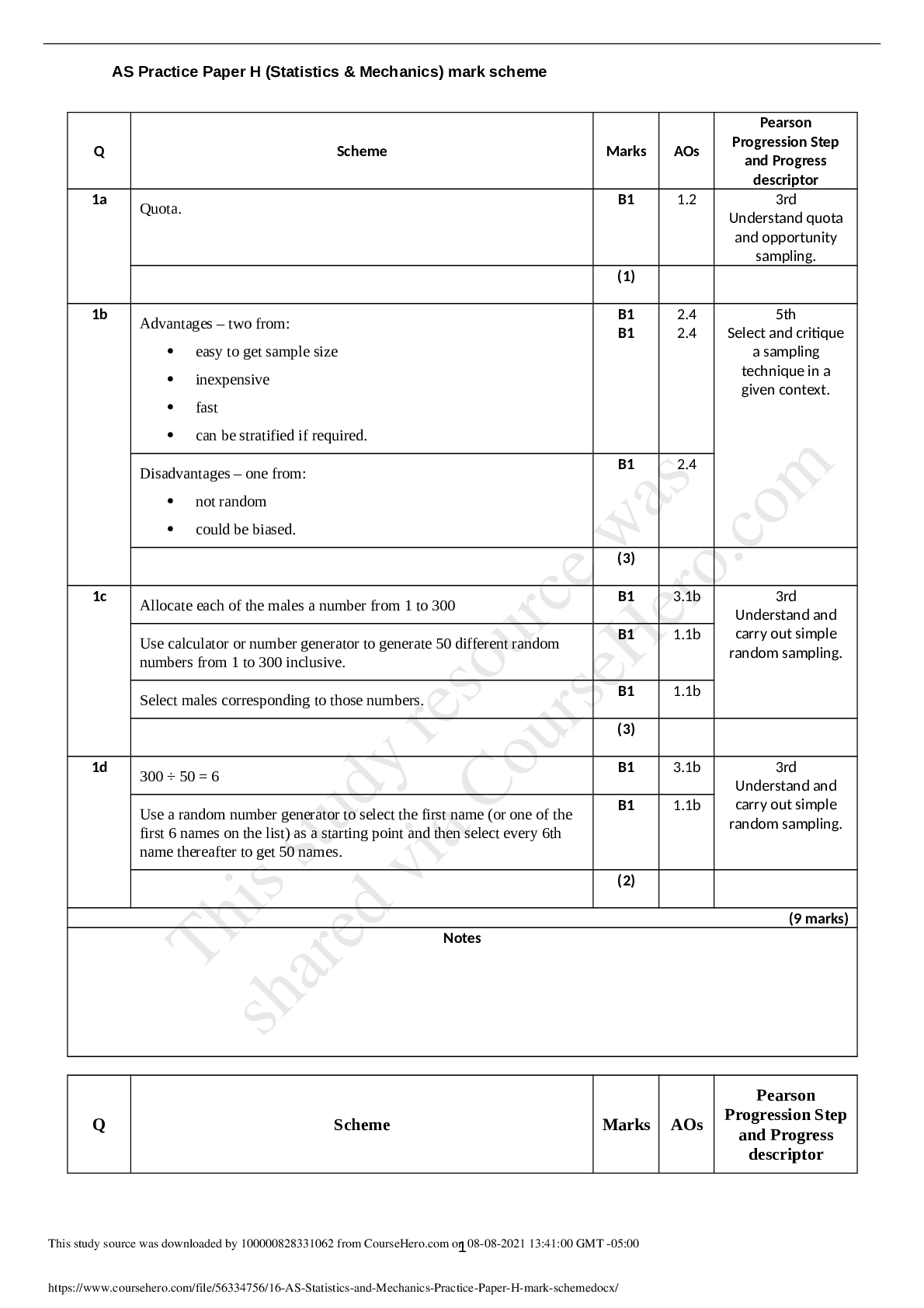


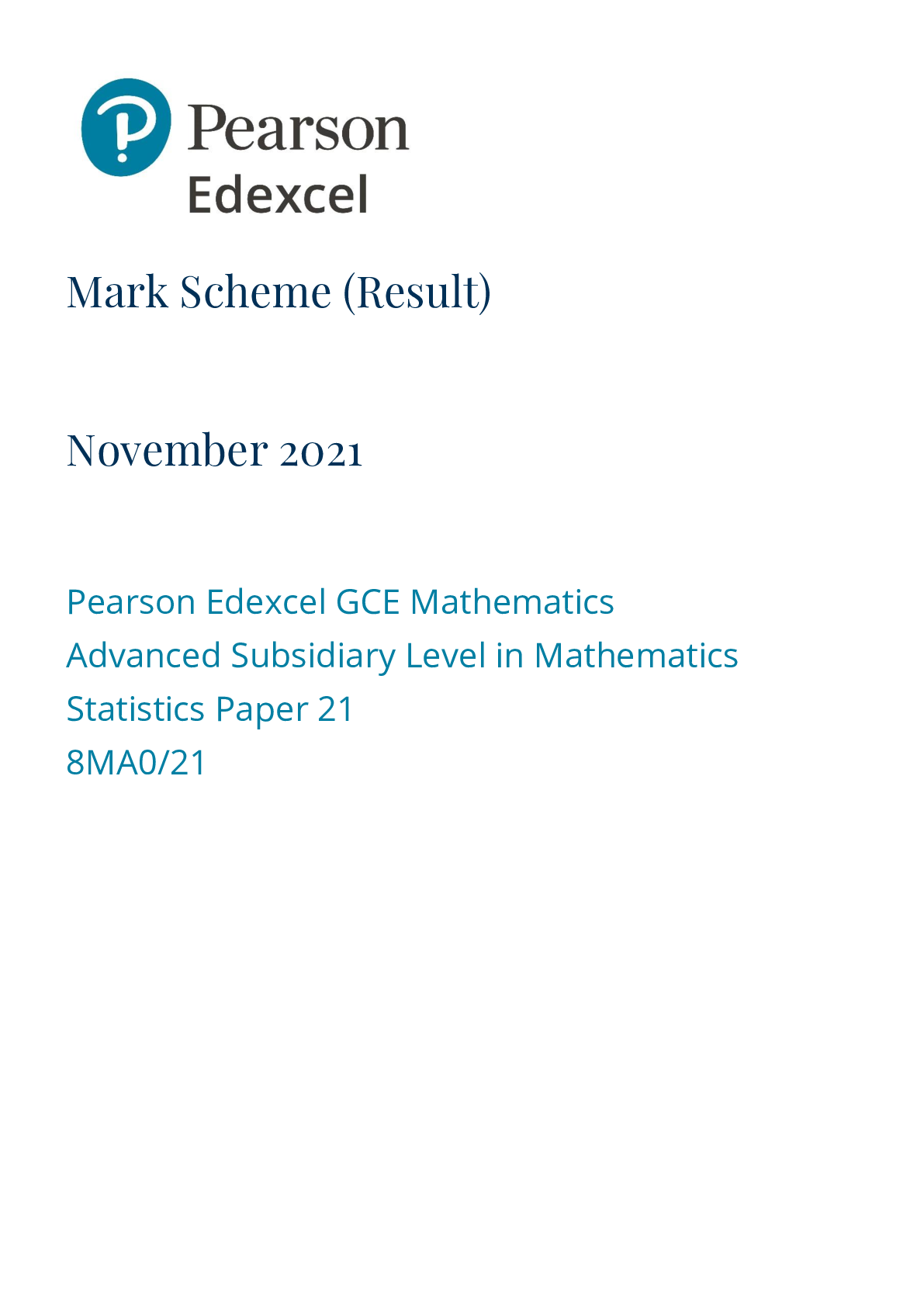
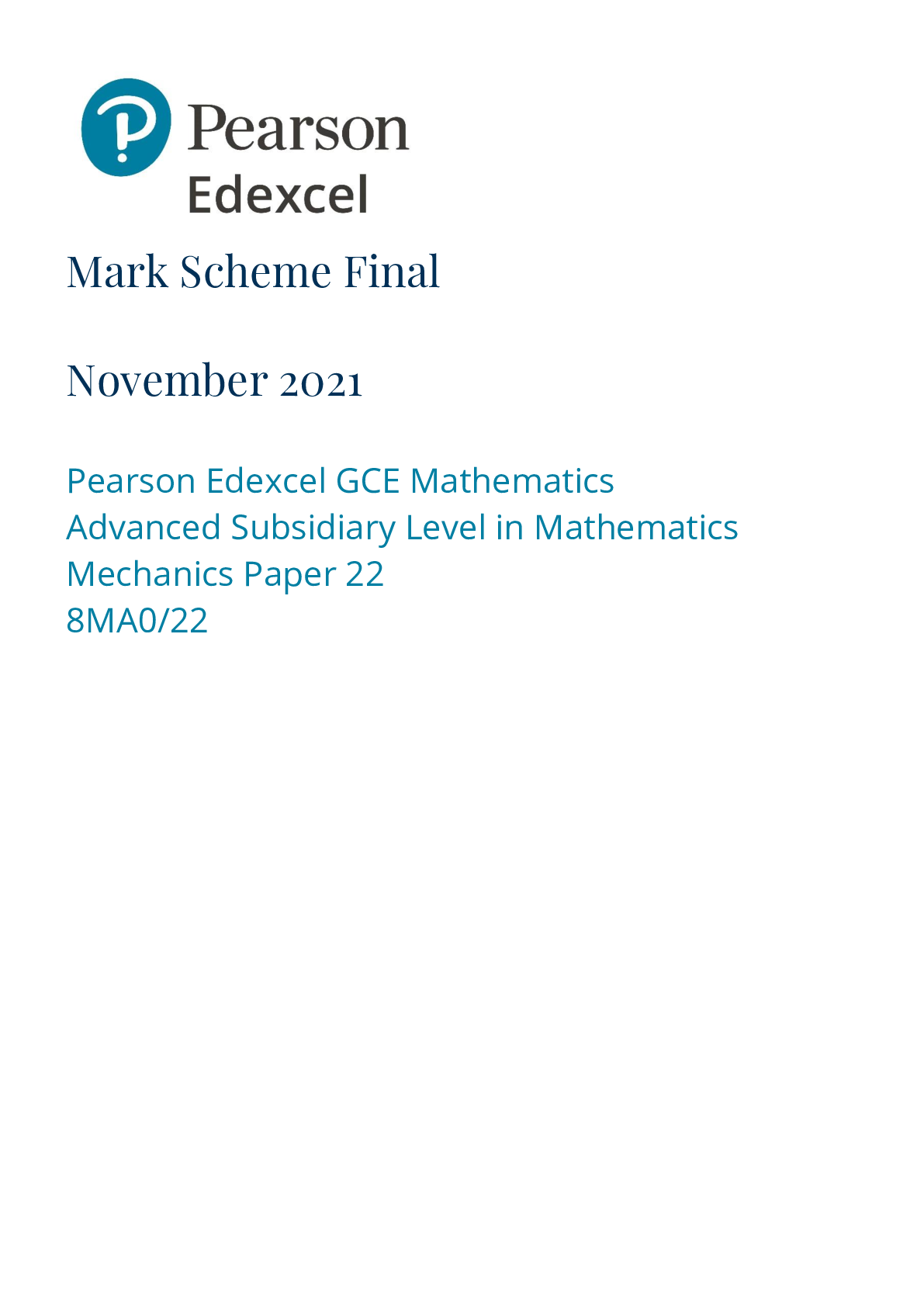
 October 2020 Pearson Edexcel GCE In AS Level Mathematics 8MA0 Paper 1 Pure Mathematics.png)
